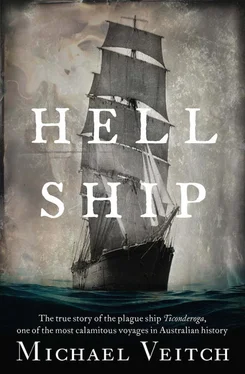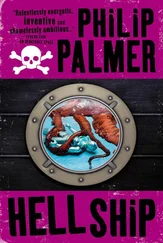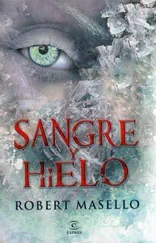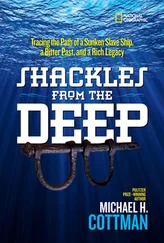The captain would usually leave the final preparations to his first mate while he attended to paperwork and final discussions with the owners and emigration officials on shore about the route to be taken, and also what to expect about Port Phillip and its approaches—particularly the entrance to Port Phillip Bay, well known as a particularly difficult stretch of water to navigate. To this effect, he would also receive his Notes to Mariners, officially prepared for sea captains and containing the latest information and nautical advice about the sea lanes and ports they were to visit. There was also a last private briefing with Captain Patey, an experienced seaman himself. Once more, the route would be discussed, along with the foreseeable dangers, the crew and of course the welfare of the passengers. It was once again impressed upon Captain Boyle that he was carrying a large, virtually unprecedented number of people on a very long voyage, and that their welfare was paramount.
Boyle’s arrival on board sent a charge of authority coursing through the Ticonderoga ’s timbers, and the settling passengers could sense a new energy and confidence in the crew. Departure was now imminent and unstoppable. Captain Patey followed Boyle aboard, accompanied by Liverpool’s Assistant Emigration Officer, Mr Kenneth Sutherland, who made one last round of the lower decks. The three held a brief final conference, exchanged paperwork officially handing the ship over to the captain and shook hands. All were pleased with what they saw of the Ticonderoga ’s preparations. [7] Kruithof, 2002, p. 40
Having given Boyle the all-clear to depart, Patey and Sutherland proceeded down the gangway. At the bottom waited one final figure to whom Sutherland uttered the words ‘The ship is yours, Mr Pilot’ as he passed. The man bowed slightly, then confidently strode up onto the vessel, the last person to come aboard. Greeting Captain Boyle, both men headed for the forecastle, positioning themselves just behind the helmsman, who clutched the Ticonderoga ’s big wheel and prepared to hand it into the capable hands of the pilot, who would guide the big ship out through the mouth of the river into Liverpool Bay.
It was an uncharacteristically warm, muggy day with high cloud. Every one of the Ticonderoga ’s nearly 800 passengers crowded onto the ship’s upper deck. Suddenly, shouted commands to ‘Cast off starboard! Cast off port!’ were heard, then relayed down the length of the ship as ropes were dropped and slack taken up. Then the sound of a steam whistle and the churning of water could be heard as two steam-driven tugs began to pull the Ticonderoga away from the wharf. At once, a passenger gave a shout, ‘Three cheers for Mr and Mrs Smith!’ and three throaty ‘hurrahs’ rose in chorus. The two figures on the wharf acknowledged the gesture, Mr Smith removing his hat and bowing to those people whose last days in England he and his wife had done their best to make as easy as possible. Beside them, Captain Patey also accepted some of the praise with a salute. All three knew, however, that no matter what awaited their passengers on the journey, the days ahead would be a great deal harder than they could even imagine. Each offered up a silent prayer.
As the great ship moved slowly out into the wide Mersey River, people gathered along the river’s banks to see her off. Small craft of all descriptions—skiffs, ferries and fishing boats, dwarfed by the great clipper ship—darted about her like excited minnows. Then there was a sudden booming, which echoed in a ripple across the river, and the Ticonderoga was enveloped in smoke, causing many of her passengers to let out a startled cry and wails to arise from the children. In a grand gesture of farewell, all eight of the ship’s cannons—kept on all ships of size at the time—had been loaded blank and fired. [8] Letter recalling the event by passenger Christopher McCrae
Those watching her on shore were heartily impressed and echoed the gunfire with a roar of approval of their own. Under partial sail and still accompanied by her tugs, the Ticonderoga emerged majestically from her self-created shroud of blue-grey smoke and headed down the Mersey as handkerchiefs were waved and eyes, swollen with tears, watched the shapes of loved ones and friends recede.
Once out into the river, the cry went out from the first mate, ‘All ready forward?’ and ‘Mainsail, haul!’ Then there was a rush of men heading aft, pulling on the braces to turn the gigantic spars towards the breeze. ‘Steady your helm! Keep her full!’ continued the cries as the Ticonderoga put on sail. Sometimes large ships would be caught in the doldrums, occasionally for weeks, pathetically close to their departure point, waiting for the winds to pick up and their journey to begin. The Ticonderoga was lucky this early August day, however, and a decent breeze was standing by to fill her sheets as she passed through the wide mouth of the Mersey. The small craft that had come to see her off gradually dropped away. The passengers looked up to the rigging in amazement, still unused to the sight of men clambering across it like monkeys, apparently oblivious to the deadly drop to the deck below. Then, with the brief sound of a steam whistle, the tugs pulled away.
Once past the mouth of the Mersey, the Ticonderoga shortened sail briefly to allow a pilot vessel to come alongside. The pilot wished the captain the best for the long journey and handed the big oak wheel over to the helmsman. A call went around for any last messages to be taken ashore and a few notes were hastily scribbled. Some passengers watched in silence as he descended the ship’s ladder, taking with him their last connection to the old world. Now they were finally and entirely on their own. If all went to plan, nothing would be heard of the Ticonderoga or the souls on board until they reached the shores of Australia.
Suddenly, they were out into Liverpool Bay heading due west along the coast of Wales. Had they kept going, they would have sailed across the Irish Sea almost directly into Dublin Bay; instead, many hours later, they rounded the island of Holyhead, passed the famous South Stack Lighthouse then proceeded through St George’s Channel, running between Ireland and Wales, before turning onto the heading that would barely alter for two months: due south. Way over on the port side, some took a last glimpse at the home they knew they would never see again, and the last sight of land ebbed quietly over the horizon.
10
Clearances and famine: The tragedy of the Highlands
When the Scots emigrants walked up the gangway from the Birkenhead depot onto the Ticonderoga ’s deck for the first time, more than a century had passed since the day in 1746 when, on a bleak moor near Inverness, the old dream of a Scottish king returning to the British throne was buried once and for all in blasts of musket and grapeshot. Yet, 106 years later, the Duke of Cumberland’s guns still reverberated in echoes of despair throughout the Highlands.
Even in their forefathers’ time, only a fraction of the clans [1] Prebble, 1963, p. 13
had supported the delusions of the so-called Young Pretender, Charles Edward Stuart. His wild-eyed followers hurled flowers into his path, dubbed him their ‘Bonnie Prince’, their dark-eyed Roman Catholic darling, their saviour—all this despite him having placed not so much as a foot on Scottish soil until the age of 25, and the fact that his title ‘Prince’ existed in name only. Most other Highlanders watched in dread and foreboding as this Great Jacobite Rebellion, this fancy of the Catholics and those mad, unpredictable Episcopalians, gathered its brief head of steam before shattering in disaster as a rag-tag army of half-starved clansmen withered in front of the Duke of Cumberland’s Regiments of Foot, two of which happened to be Scottish themselves. But despite many not supporting the uprising, all would be made to suffer its defeat.
Читать дальше












